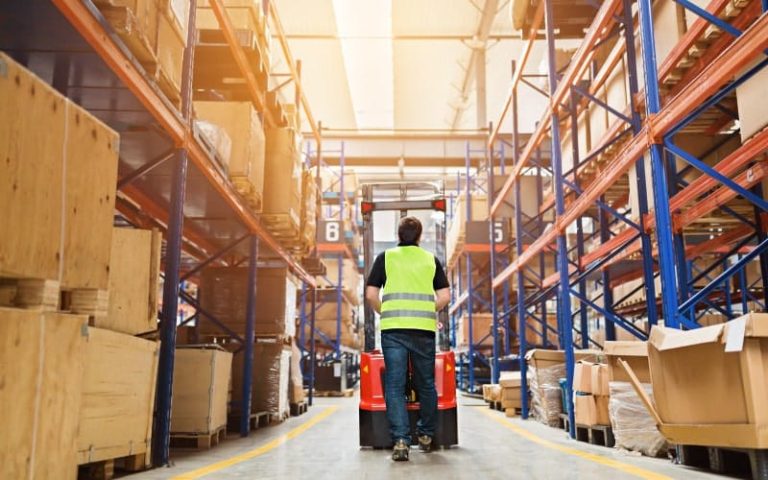The operations of a business must run smoothly and efficiently in order for it to be successful. This includes ensuring that the supply chain is running optimally. Material handling is a huge part of any effective supply chain.
Material handling is the movement, protection, storage, and control of materials and products throughout manufacturing, warehousing, distribution, consumption, and disposal.
Handling materials used to be looked at as having three distinct stages:
- materials collection;
- manufacturing; and
- product distribution.
But today, material handling is viewed in a more integrated manner from start to finish. Transporting goods in larger quantities using a variety of systems and equipment that best support the supply chain and logistics of a business.
What is a Material Handling System?
A material handling system is the specific way in which a business moves, protects, stores, and controls its materials. Effective material handling systems are important because they:
- Address your biggest issues
- Save space
- Increase efficiency
- Reduce accidents
- Decrease time for order fulfillment
- Improve customer satisfaction
- Decrease handling costs
There are four components of a material handling system that can impact your warehouse efficiency: movement, time, quantity and space.
- Movement – Moving a product from receiving to outgoing
- Time – The time it takes from receiving inventory to shipping it out
- Quantity – The amount of product that can be stored in the space available
- Space – The amount of space available for storing product
Types of Material Handling Systems
There are several different types of material handling systems that can be used to get materials from point A to point B both effectively and efficiently.
1. Manual Material Handling
Manual material handling has workers use their hands to move materials and containers. This includes lifting, lowering, filling, emptying, and carrying the containers during transport. The main problem with manual material handling is that it puts workers at greater risk for physical musculoskeletal injuries, especially to the back, shoulders, and upper limb issues.
2. Automated Material Handling
Automated material handling has equipment that either reduces or replaces the manual handling of materials. The struggle with automated material handling is that it is often difficult to achieve depending upon the task, or expensive. Automated solutions include utilizing different types of material handling equipment:
Conveyor systems – These can be used to move goods from one part of a facility to another while minimizing damage to materials.
- Automated guided vehicles (AGVs) – Driverless electric vehicles are used to transport materials within a warehouse or facility. They follow specific set paths and leverage navigation technology to detect obstacles and stop when necessary.
- Automated storage and retrieval systems (AS/RS) – These are computer-controlled systems that are programmed to store and retrieve materials with both speed and accuracy.
- Autonomous mobile robots (AMRs) – These are robots that leverage navigation technology which enables them to autonomously map out and determine their own path within a facility and avoid obstacles as they move.
Better equipment can help you lift heavy materials, move materials faster, store them efficiently, and keep your warehouse team safe.
3. Semi-Automated Material Handling
Unfortunately, it can be difficult and expensive to automate certain human operations such as driving, loading, or unloading containers. For this reason, many material handling machines are semi-automated. While we continue to work towards a fully automated future with improvements in things like robotics, machine programming, and other types of artificial intelligence, we haven’t achieved this yet.
Designing a Material Handling System
One of the most important things that you must do is design your material handling system for your warehouse. How you do so will greatly impact how your supply chain functions and your materials move throughout the process. When designing your material handling system, you must consider the following:
Warehouse Systems and Planning
Warehouse systems and planning takes safety, cost-reduction, and sustainability into consideration. Having a safe working environment, reducing operating expenses, and reducing waste is key. Knowing current industry trends, equipment, and systems can prove invaluable. You will want to ask yourself the following:
- Are you purchasing new equipment?
- What needs to be installed or upgraded?
- Do you have used equipment to sell?
- How will you develop your concept?
- What is the layout of your plant/warehouse?
- Do you need an automated storage and retrieval system?
You should also consider warehouse space planning and layout, budget, supply, and installation.
Installation and Dismantling
It’s important to figure out your electrical, mechanical, and equipment needs as well as sorting and order picking systems. Outsourcing this can allow you to begin operating sooner. Consider whether you would benefit from a material handling equipment company, which could help evaluate purchase opportunities for you or even purchase used equipment from you directly.
Warehouse Liquidations
Another thing to consider is whether you have any equipment that needs to be dismantled and sold and whether your warehouse liquidation will require outsourced labor.
Custom Fabrication
You will want to explore which fabrication services will fit your warehouse racking, shelving, and mezzanine needs. Material handling suppliers can help with this.
Warehouse Relocation
If you are relocating, you will want to consider whether you are selling, dismantling, and removing your existing equipment, and how you will prepare the new location.
The Importance of Implementing Quality Material Handling Systems
Everything in business costs money – money that you’d probably like to keep in your pocket. For this reason, you may be hesitant to spend the money necessary to implement new equipment and systems. But while cutting corners will save you money in the short-run, it could cost you much more down the line.
Without the assistance of a quality material handling system for your business, you face many risks, such as increasing labor costs, health risks to workers (potential cases of workers’ compensation), delays, inaccurate order fulfillment, lower customer satisfaction, and subsequent lost business. Does this sound complicated? It certainly can be. Fortunately, you don’t need to come up with the answers all on your own. Material handling professionals like Conesco can help.
Conesco offers turnkey warehouse solutions to a wide variety of customers. We buy, sell, and provide services for material handling and equipment:
- New and used material sales
- Warehouse liquidations
- Labor services
- Logistics coordination
- Warehouse plans & strategy
- Engineering and permitting
- Project management
- Facility/material consulting
Our knowledgeable and experienced sales team can help you determine the best solution to fit your needs. We’ll communicate your timeline and create a plan that saves you both time and money.
Whether you’re a 3PL, fulfillment center, distribution center, storage warehouse, or manufacturer, Conesco provides material handling solutions to help fulfill your needs, reduce your overall costs, and increase your bottom line.



